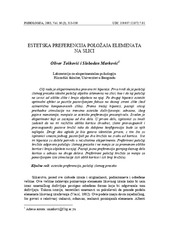Prikaz osnovnih podataka o dokumentu
Estetska preferencija položaja elemenata na slici
Aesthetic preference of object position on pictures
| dc.creator | Tošković, Oliver | |
| dc.creator | Marković, Slobodan | |
| dc.date.accessioned | 2021-10-12T10:29:10Z | |
| dc.date.available | 2021-10-12T10:29:10Z | |
| dc.date.issued | 2003 | |
| dc.identifier.issn | 0048-5705 | |
| dc.identifier.uri | http://reff.f.bg.ac.rs/handle/123456789/425 | |
| dc.description.abstract | Cilj rada je eksperimentalna provera tri hipoteze. Prva tvrdi da je položaj zlatnog preseka idealni položaj objekta (elementa) na slici, kao i da taj položaj ne zavisi od oblika slike i broja objekata na njoj. Po drugoj hipotezi estetski optimalni efekat se postiže postavljanjem fokusa na desnoj strani slike (kod asimetrično komponovanih slika). Prema trećoj hipotezi, postoji uticaj prethodne stimulacije na trenutno estetsko doživljavanje; odnosno, zbog pojave monotonije, menjaće se estetska preferencija procenjivača. Izveden je eksperiment koji se sastojao od dva dela. U prvom delu, ispitanici su imali zadatak da na tri različita oblika kartica (kvadrat, zlatni pravougaonik i pravougaonik) postave kružić tako da dobijena konfiguracija bude za njih najlepša. Drugi deo ogleda je bio gotovo identičan prvom, s tim što su ispitanici umesto jednog, postavljali po dva kružića na svaku od kartica. Sve tri hipoteze su dobile potvrdu u rezultatima eksperimenta. Preferirani položaj kružića odgovara položaju zlatnog preseka i ne menja se sa promenom oblika kartice i broja objekata na njoj. Postoji jasna preferencija gornjeg desnog dela kartica u odnosu na druge delove. Preferirani položaj kružića se menja sa ponavljanjem iste stimulacije (isti oblik kartice i isti broj kružića). | sr |
| dc.description.abstract | In this study three hypothesis were evaluated. The first claims that the golden section position is an ideal position of an object on a picture and that this position does not depend on picture shape, or on the number of objects on it. According to the second hypothesis, the aesthetically optimal effect is achieved when the focus is on the right side of the picture ( for asymmetrically composed pictures). According to the third hypothesis, there is an influence of previous stimulation on aesthetic experience; that is, because of the monotony, the aesthetic preference of observers will change. An experiment was done, with two sections. In the first section, subjects were asked to put a little black circle, on three different shapes of cards (square, golden rectangle and rectangle), in a such way that the given configuration is the most beautiful one in their own opinion. The second section of the experiment was almost identical to the first one, with the exception that the subjects were asked to put two circles on each of the cards. Each one of the three hypothesis was confirmed by the results of this experiment. The preferred position of the circle is the same as the position of the golden section and it does not change with the change of card shape and number of objects. There is a clear preference of the upper-right corner of cards. The preferred position of an object is changed with repetition of the same stimulation (the same shape of cards and the same number of circles). | en |
| dc.publisher | Društvo psihologa Srbije, Beograd | |
| dc.rights | openAccess | |
| dc.rights.uri | https://creativecommons.org/licenses/by-sa/4.0/ | |
| dc.source | Psihologija | |
| dc.subject | položaj zlatnog preseka | sr |
| dc.subject | estetska preferencija | sr |
| dc.subject | golden section position | en |
| dc.subject | aesthetic preferences | en |
| dc.title | Estetska preferencija položaja elemenata na slici | sr |
| dc.title | Aesthetic preference of object position on pictures | en |
| dc.type | article | |
| dc.rights.license | BY-SA | |
| dc.citation.epage | 330 | |
| dc.citation.issue | 3 | |
| dc.citation.other | 36(3): 313-330 | |
| dc.citation.spage | 313 | |
| dc.citation.volume | 36 | |
| dc.identifier.doi | 10.2298/PSI0303313T | |
| dc.identifier.fulltext | http://reff.f.bg.ac.rs/bitstream/id/1983/422.pdf | |
| dc.type.version | publishedVersion |

